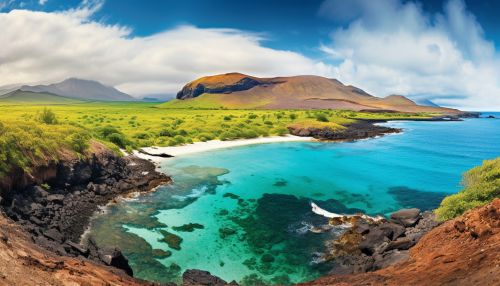Galápagos Islands
Geography
The Galápagos Islands are an archipelago of volcanic islands distributed on either side of the equator in the Pacific Ocean. The islands are located around 906 km west of continental Ecuador, of which they are a part. The Galápagos archipelago consists of 18 main islands, 3 smaller islands, and 107 rocks and islets. The largest of the islands, Isabela, measures 4,640 square kilometers and makes up half of the total land area of the Galápagos. The islands are known for their vast number of endemic species, which were studied by Charles Darwin during his second voyage of the Beagle. His observations and collections contributed to the inception of Darwin's theory of evolution by means of natural selection.


Geology
The Galápagos Islands are characterized by their unique geology. The archipelago is located on the Nazca tectonic plate. This fast-moving plate is heading eastward over the Galápagos hotspot and has formed the chain of islands. The islands were formed through the process of plate tectonics, causing the underwater volcanoes to emerge above the ocean's surface. The age of the islands varies from less than 1 million years for Fernandina to more than 4 million years for Espanola.
Climate
The Galápagos Islands have a highly variable climate, as does Ecuador's mainland. There are two seasons in the islands: the hot and rainy season, from December to June, and the cool and dry season, from June to November. The climate of the Islands can also be influenced by the El Niño events, which occur every two to seven years.
Biodiversity
The Galápagos Islands are renowned for their extraordinary wildlife. Many of the species found on the islands are not found anywhere else in the world, making the archipelago a unique destination for scientists and tourists alike. The islands are home to a variety of species, including the Galápagos tortoise, the marine iguana, the Galápagos penguin, and various types of finches. The islands' isolation has allowed species to evolve independently, leading to the development of unique adaptations and the evolution of new species.
Conservation
The Galápagos Islands are a UNESCO World Heritage site and are home to one of the most fragile ecosystems in the world. Conservation efforts are critical to maintaining the unique biodiversity of the islands. The Galápagos National Park Directorate (GNPD) is responsible for the conservation and management of the islands. The GNPD works in partnership with the Charles Darwin Foundation and other international organizations to protect the islands' wildlife and ecosystems.
Tourism
Tourism is a major industry in the Galápagos Islands. The islands attract thousands of visitors each year who come to experience the unique wildlife and landscapes. However, tourism also poses challenges to the conservation of the islands' ecosystems. The Galápagos National Park Directorate regulates tourism activities to minimize impacts on the environment and wildlife.
